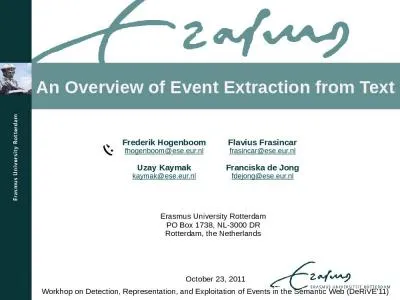PPT-Transactions (and event-driven Programming)
Author : min-jolicoeur | Published Date : 2016-11-28
EE324 Concurrency Control General organization of managers for handling transactions 2 Twophase locking is pessimistic Acts to prevent non serializable schedules
Presentation Embed Code
Download Presentation
Download Presentation The PPT/PDF document "Transactions (and event-driven Programmi..." is the property of its rightful owner. Permission is granted to download and print the materials on this website for personal, non-commercial use only, and to display it on your personal computer provided you do not modify the materials and that you retain all copyright notices contained in the materials. By downloading content from our website, you accept the terms of this agreement.
Transactions (and event-driven Programming): Transcript
Download Rules Of Document
"Transactions (and event-driven Programming)"The content belongs to its owner. You may download and print it for personal use, without modification, and keep all copyright notices. By downloading, you agree to these terms.
Related Documents





![[READING BOOK]-Architekturpatterns mit Python Test-Driven Development, Domain-Driven Design](https://thumbs.docslides.com/970121/reading-book-architekturpatterns-mit-python-test-driven-development-domain-driven-design-und-event-driven-microservices-praktisch-umgesetzt-german-edition.jpg)
![[DOWLOAD]-Architekturpatterns mit Python: Test-Driven Development, Domain-Driven Design](https://thumbs.docslides.com/974565/dowload-architekturpatterns-mit-python-test-driven-development-domain-driven-design-und-event-driven-microservices-praktisch-umgesetzt-german-edition.jpg)
![[FREE]-Programming 58: C++ Programming Professional Made Easy & Windows 8 Tips for Beginners](https://thumbs.docslides.com/980128/free-programming-58-c-programming-professional-made-easy-windows-8-tips-for-beginners-c-programming-c-language-c-for-beginners-c-programming-programming-windows-8-c-programming.jpg)
![[eBOOK]-Programming 19:C Programming Professional Made Easy & Excel Shortcuts (Excel Programming,](https://thumbs.docslides.com/980131/ebook-programming-19-c-programming-professional-made-easy-excel-shortcuts-excel-programming-microsoft-excel-python-for-beginners-c-programming-c-programming-languages-android-c-programming.jpg)
![[BEST]-Programming 11:C Programming Success in a Day & Rails Programming Professional](https://thumbs.docslides.com/980146/best-programming-11-c-programming-success-in-a-day-rails-programming-professional-made-easy-c-programming-c-programming-c-programming-language-rails-android-programming-ruby-rails-php-css.jpg)
![[PDF]-Programming 3: Python Programming Professional Made Easy & C Programming Success](https://thumbs.docslides.com/980147/pdf-programming-3-python-programming-professional-made-easy-c-programming-success-in-a-day-c-programming-c-programming-c-programming-language-html-python-programming-python-java-php.jpg)

